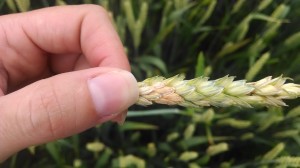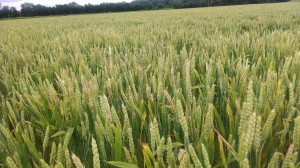Wheat in Tennessee has entered the ripening stage (Feekes 11 – kernel development) and symptoms of Head Scab can be seen in some fields.
Symptoms of Head Scab (Fusarium Head Blight) may be visible in fields before wheat starts to turn golden and fully mature. There is nothing to be done about scabby wheat now, as the window to apply fungicides has passed. Fungicides applied to manage Head Scab have a Pre-Harvest Interval (PHI) of 30 days, which roughly equates to 6 days after flowering (see Wheat Fungicide Table). While wheat can be infected from head emergence until harvest, infections initiated at and soon after flowering have the greatest destructive potential and that is why the recommended window for fungicide application is at bloom to manage scab.
I’ve gotten calls and visited fields in Tennessee that have varying levels of scab infection this past week (from little to none, up to 40-50% heads affected). Factors that affect scab infection and severity include:
- variety (some may have more tolerance than others)
- plant date/time of flowering
- weather (temperature and moisture before, during and after flowering)
- previous crop (higher severity is likely in wheat planted behind corn)
- fungicide application (product, timing, and coverage)
In west Tennessee from May 5 through May 13 warmer temperature (highs in the upper 70s and 80s and lows above 60 °F) were in the range for Head Scab infection to occur if wheat was flowering and received rain/irrigation. Even fields that did have a fungicide application (only solo triazole products should be applied at flowering) may have Head Scab infection because even in an ideal situation (i.e. all the wheat in a field is flowering at the same time) an application is not going to give 100% control. Additionally, timing and coverage also effect efficacy of fungicides to manage scab. The best way to know how much a fungicide managed a disease is to have some unsprayed strips left in the field to compare the sprayed area with. Appropriate fungicides applied at the right timing have reduced scab severity levels by 50-60% across multi-state trials.
Symptoms of scabby wheat include bleached spikelets or entire heads. On bleached spikelets the fungus appears as pink or orange growths, usually at the base of a disease spikelet (image below). Diseased spikelets are often sterile or have discolored or shriveled seed, that is chalky in appearance and can be referred to as “tombstones”. Yield reduction is due the sterile florets and poor seed filling. If saving seed from a scabby wheat field, the combine can be set where the diseased kernels will be blown out when harvesting, although some symptomless seed may be affected and have poor germination the following year and a seed treatment is recommended.
In addition to reduction in yield, scabby wheat may contain mycotoxins, usually deoxynivalenol (DON or vomitoxin), and grain may be docked or rejected based on the level present. The consumption of mycotoxin-contaminated grain has been associated with several acute and chronic diseases in humans and animals. The level of DON in grain, flour, and finished products derived from wheat is regulated, with various limits set by different countries (for more info on U.S. guidelines for DON levels visit: http://www.fda.gov/Food/GuidanceRegulation/…). Scab is not usually problematic in Tennessee every year, only when the right conditions occur (temperature between 59-86 °F, ≥ 90% relative humidity/rain event) during flowering time period and unfortunately it looks as if this year the right conditions have occurred in some areas of Tennessee.




With the increased use of vertical tillage implements following corn harvest, there appears to be more wheat planted in those same fields. Historically, my best fields to no-till wheat into were either cotton or single-crop soybean. Since cotton acres have declined so much, the diversified farmer in west TN is left with only soybean or corn fields to plant wheat.
Would you suggest a disease management approach if a previous crop corn field is chosen for wheat production?
Many thanks.
Richard,
Wheat planted behind corn is at higher risk for head scab and I would recommend a more proactive head scab management approach in such fields. Vertical or ‘turbo tillage’ has been listed to reduce the inoculum potential and wheat planted behind corn residue has a higher potential to benefit from a triazole fungicide applied during bloom. It is unfortunate there aren’t more rotation options right now, but head scab is not an issue every year in Tennessee and hopefully the Fusarium Head Blight prediction model (at http://www.wheatscab.psu.edu) will continue to get better and Tennessee might get additional weather stations to feed into the prediction site to better assess the yearly risk of head scab. Thank you for your comment/question.
Best Regards,
Heather